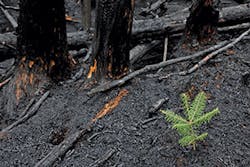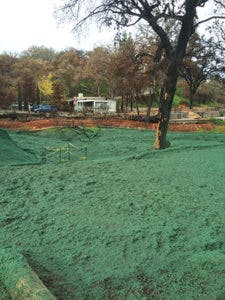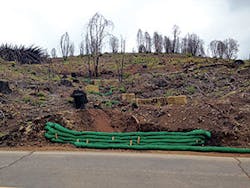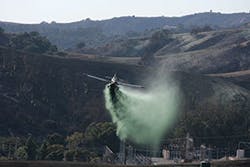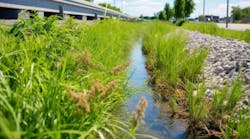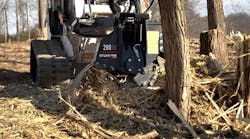Royal Gorge Reclamation
It was in June 2013 that the 3,200-acre Royal Gorge fire broke out near Cañon City, CO, situated about 45 miles southwest of Colorado Springs. The wildfire destroyed almost everything in its path (48 out of 52 structures in Royal Gorge Park were lost), although surprisingly it spared the Royal Gorge Bridge above the Arkansas River. Of the 1,292 wooden planks that make up the bridge, only 32 were destroyed.
Restoring the area in the aftermath of the fire was jointly undertaken by a number of agencies.
“When a fire hits and the response teams come in, they take over,” explains Rick Romano, district conservationist with the area’s Natural Resources Conservation Service. “If it involves federal land, they put together a BAER—Burned Area Emergency Response—team. They have specialists such as hydrologists, soils people, wildlife people, and archaeologists.
“They scour the area and come up with a report. In this case, it was a 3,200-acre fire, but only about 500 acres of it was on Bureau of Land Management land, and they didn’t feel any necessity to put together this team.
“When the fire happened, I made a phone call to the district forester with the Colorado State Forest Service, because we worked together on earlier fires when the federal government wasn’t involved.
“We offered our services and our experience to the city, and we put together a team including the Cañon City water superintendent, the Cañon City Parks Department, the Fremont County Office of Emergency Management, and a representative from the Bureau of Land Management. This BLM representative’s participation was crucial in the early days. He really helped us put together our damage survey report and cost estimates for
The funding also paid for reseeding a number of the flatter areas in the burn zone. A total of 886 acres were seeded aerially.
“Our seed mix, supplied by Granite Seed Company, consisted of seven or eight native grasses, 10 native wildflowers, and some of the mix had three different native shrubs,” notes Romano. “We also put down almost 19,000 pounds of winter triticale, which is a cross between winter wheat and winter rye. It’s not as aggressive a reseeder as winter rye is. That was sort of our nurse crop.”
Gap fire
As fate would have it, though, the weather became an issue, and Romano had to make a crucial decision.
“We scheduled the seeding on February 11 because that was the only day the helicopter could be there. But then a snowstorm was predicted for that time, so I called up all my peers, asking them if they had ever seeded over snow, and what the results were. Almost to a person, they responded that they had never done it, but they wanted to know how it works out.
“I had worked with some ranchers around here, and sometimes if they had bare areas, they would just have a bag of grass seed in their pickup truck. If there was a snow, they would just scatter the seed over the snow. They said the seed would go through the snow and basically freeze to the surface of the ground and stay there.
“So I decided to go for it. We did have four to six inches of snow the day before the seeding. They went ahead and seeded the 886 acres. Nine days later, on February 20, we brought in Hydro-Ax machines. They started going over the ground and masticating and mulching the trees. These machines are like brush hogs on steroids. It’s like a front-end loader with what they call a spinning ax in front. They go up to these trees and just chew them up in seconds, and the tree is gone.
“I came back a couple days after the seeding, and I was amazed that you could see where the snow was melting and the water was running off, and for the most part, the seed was staying in place. Some was going in the water, but by that time we already had some of those check structures built, so we were hoping to catch some of that seed behind these check dams anyway.
“We brought in these Hydro-Ax machines with their big rubber tires, and the company had put chains on the tires. You could actually see the pattern in the soil. They treated 1,369 acres with the machines. This included all of the area that was seeded, plus some more.”
Initially, Romano says, the plan had designated only about 700 acres for the Hydro-Ax treatment, because the team expected the slopes to be too challenging. “We were amazed at the slopes they could cover,” he says.
As for the results of the seeding?
“We thought we had a tremendous response from everything. I was almost worried at first that the triticale might have come on too strong, even though with the mix, there were only four seeds per square foot. But most of them must have germinated, because it really did a good job of covering the ground.
“What I took from that is that this is an important extra step after broadcasting seed. In a lot of cases when you broadcast seed, unless you hit moisture just right, you’re just being kind to the birds. But in this case, those cleats on the tire chains, together with the weight of the machine, pushed the seed into the ground and increased the seed-to-soil contact. I’m really sold on this as a reclamation effort.
“We also did some hand-seeding in areas where we didn’t do aerial seeding for one reason or another. So we did an additional 34 acres of hand seeding, with volunteers that came in.”
Romano notes that there was also a good amount of natural revegetation that occurred, but he was interested to get a sense of how much new growth was coming in.
“I went out there with a representative from Granite Seed. You always get a nutrient flush after a fire, so if the crown of the plants isn’t burned off, you’ll get a very robust bit of growth. We dug up a bunch of plants and we were able to determine that a lot of them were new plants, not just old plants that had been reinvigorated.”
On this restoration effort, the bulk of the erosion and sediment control work was accomplished with the extensive seeding, aided by the Hydro-Ax mulching, and the many check dam stabilization structures.
After some other fires, log erosion barriers have been used, in which downed trees, supported by remaining stumps, slow down the movement of water and sediment. For the Royal Gorge fire, however, Romano says this wasn’t a viable option.
“We did not put in any log erosion barriers because the pinyon pines are not suitable for that. They’re too crooked; they’re too small. When you’ve got something like ponderosa pine or Douglas fir, then you can think about cutting those logs up and putting them across a slope, but not in this case.”
Over the subsequent three years—2014, 2015, and 2016—the Fremont Conservation District sponsored the planting of roughly 10,000 seedling trees. The group effort has definitely paid off.
“I can’t emphasize enough how important it was on this project to have a research community available to work together on this,” says Romano. “No one agency can do this effectively on its own. Being able to work with the state forest service, the City of Cañon City, the County Office of Emergency Management, and the BLM, and having the Conservation District for support, was crucial.”
Site of the Valley fi re in Lake County, CA
Hydroseeding and the Three Elements for Success
Three wildfires in northern California, about 100 miles north of San Francisco, kept Jay Selby busy from late 2015 through the fall of 2016.
“There was the San Andreas fire in Butte County and another in Lake County,” says Selby, president of Selby Soil Erosion Control Company. “We were working on
the residences that got completely destroyed. We were working on both of these simultaneously in 2015 and 2016. Then another fire broke out in Lake County in 2016, and we wrapped that up in late 2016.
“Devastation was pretty great on the Lake County fires. The first Lake County fire took out about 1,200 homes. The second Lake County fire, in the summer of 2016, took out another 400 structures. The Butte County fire, the San Andreas fire, destroyed 835 homes.
“A lot of these homes were older homes, so when they completely burned up, you then have asbestos and lead that actually penetrate into the soil, contaminating the soil. Because of this, FEMA brought out full Hazmat crews, fully suited up. They excavated, got all the foundation, all the building material, and also took about a 4- to 6-inch layer of topsoil off of these lots. Then they ran testing on the remaining soil to make sure they got all the contaminants out of it.”
He says that most of the affected lots passed this inspection. For those that didn’t, FEMA went back in, removed additional dirt, then retested. As FEMA completed a given area, Selby would be provided with a list of lots to seed.
“We would visit each individual lot, assess it, and figure out what kind of BMPs were going to be needed,” he says. “It might be biodegradable straw wattles or blankets, or silt fence, to protect the site a little bit better. Then we had hydroseed crews following them, shooting over the lot as they were finished with the BMPs.”
For this purpose, Selby utilized a variety of Finn HydroSeeders.
“In the Lake County fires, a lot of the residents were close together and the streets were pretty wide and big, so we were using big-tank Finn HydroSeeders on those. With the Butte County fire, the homes were more spread out and on a lot more acreage. But on some of the driveways, the clearance was really tight, so we had to use the smaller HydroSeeders. Finn Corporation makes various sizes of HydroSeeders. They make 4,000-gallon tanks and 2,800-gallon tanks—these would be mid-size HydroSeeders. A 900- or 1,200-gallon tank would be a smaller unit. We used all of them, depending on accessibility.”
Site of the Valley fire
As Selby explains, achieving effective ground cover was a crucial element of the restoration process. “They wanted to get growth established as quickly as possible, to help with the impending winter. We knew if any kind of heavy storms would roll in, we would have the possibility of mudslides, so they wanted to get that growth established as quickly as they could. They wanted the roots and the native grasses stabilizing the soil.
“As it turned out, everything grew really well. We were into the rainy season, and everything just took off. We shot it with a heavy-duty mix of 3,500 pounds of bonded fiber matrix. That really encapsulated it pretty well until the grass seed started to grow.
“You need three key elements for native grass to grow,” he notes. “You need good precipitation, for generally four to five days, so the ground gets nice and moist for germination. Then you need soil temperatures above 50 degrees, or else native grasses just won’t do anything. This is not air temperature, it’s soil temperature. The air temperature might fluctuate from 75 degrees in the daytime to 30 degrees at night, but it’s all about the soil temperature. That has to be above 50 degrees, and preferably above 55. The third key element is that you have to have some sunshine.
“If you have all those three things working together, which we’ve had the last few winters, things will go well. We had good, early rains, soil temperatures were still above 50 or 55 degrees, and some sunlight in between the rain events. That’s optimal for allowing native seeds to germinate and start growing.”
Selby says the seed mix was supplied by a local company that was working hand in hand with the heads of FEMA to come up with a mixture that would work. The seed mix used in Lake County was different from that used in Butte County because of the elevation difference and what was naturally growing in those areas before the fires.
Seeding was necessary after these fires, as there didn’t appear to be much chance for any kind of rapid natural revegetation.
“They wanted to hydroseed everywhere,” says Selby. “These fires were very, very hot. We pretty much knew that any native seeds that were left behind were destroyed in the fire. On top of that, they stripped away the top four to six inches of soil off all these sites, so there wasn’t much native there.
“With fires in a lot of forests, when the fire isn’t burning through structures, it’s moving through grassland and trees and tends to move fairly fast. In a lot of those cases, you will get a nitrogen kick from the fire, and there are seeds that aren’t destroyed. Those will often grow on their own really well, without us doing anything.
“In a fire, pine trees burn at a really, really high temperature, and oils from the trees can create a crust over the top of the soil. This is called a hydrophobic layer, and nothing can grow through that. It’s almost like a plastic layer over the top of the soil. In those situations, you have to use a method called soil roughing just to break up that hydrophobic layer. That was the case with these fires. They burned a lot longer and a lot hotter, with all the fuel for the fire from what was inside these houses.”
Access to some of the locations proved to be challenging. “Many of these driveways were tiny, without turn-around points,” says Selby, “so we had to have guys out in front making sure that equipment could get to the sites and be able to turn around. That was the reason we had various-sized tanks and HydroSeeders. We had to decide where they could get to, and if we had to pull hose onto a site because we couldn’t get all the way in. That’s a nice thing about the Finn HydroSeeders; they come with a 300-foot hose reel already attached to them, so we could park the truck and pull the hose out and get to where we needed to go.”
Additional access problems were caused by frequent mudslides in the area. “We were traveling down roads with storm drains flooded with debris and mudslides happening on the sides of the roads. Getting our equipment in and out of these sites was definitely challenging.”
Despite the difficulties, the hydroseeding proved effective. In less than a year, notes Selby, new native grass was well established.
Sierra Sedimentation
On August 17, 2013, a hunter’s illegal fire got out of control in California’s Sierra Nevada mountain range. It would be more than two months before it was fully contained, and well over a year before it was declared out. By the time it was over, more than a quarter of a million acres had been burned.
Ken Fleming, regeneration forester with Sierra Pacific Industries, was part of the effort to control sedimentation problems on more than 16,000 acres of the burned forest.
“There were some swales that didn’t have culverts on roadways, and we were trying to prevent sedimentation there,” he says. “We also did a lot of contouring in the area to help prevent hillsides from washing away prior to getting any vegetation back on the landscape. Contouring involves working to capture the moisture so it doesn’t wash the hillside away.
“We used a lot of hay bales, and we used some Filtrexx wattles as well. The Filtrexx product worked well for us. Eventually they filled up, but we dug them out and cleaned out the sediment early last fall. They did silt up and fill up, but they’re still there.
“We built dams by cutting up the Filtrexx wattles and stacking them about 18 to 24 inches high to grab the silt right before it comes onto the pavement, and these actually hold quite a bit of sediment. They filled up again this year. With the rain, it overwhelmed them.”
Fleming explains that the cleanout simply involves moving a backhoe behind the wattle dam and digging out as much of the accumulated sediment as possible. Because of frequent rain, the wattles had to be realigned in a couple spots, but for the most part, they have held up well.
In addition, Fleming notes, “We did make some short little wattles from the Filtrexx and placed them on the pavement, to direct the water that was coming off the dam into the gutter portion of the pavement. Those got moved a few times, so we had to realign those. But otherwise, everything stayed where it was supposed to.”
He says a larger catch basin would have been helpful. “Above where we put all this stuff, we didn’t think the area was going to keep bleeding like it has. That catch basin just keeps filling up, and it keeps creating a water course above us. There’s something up there that has changed, and it keeps pushing the water into the dams we built and it keeps filling up. So there’s an issue up the hill we have to deal with.
“If we had more material, it would have been nice to get up the hill and put up a higher catch basin, maybe another hundred feet higher. We would have had to get the equipment up there, because the Filtrexx is a little bit heavy, but it sticks around a lot longer than those straw wattles.”
Crews also had to take into account a decades-old fire. “We had an area that burned 40 years ago and there were some issues that had never been taken care of. We had to repair an old water course. Basically, we had to turn the creek almost 90 degrees. That actually helped. I was a bit surprised that with all the water we’ve had this past year, it held. But it did.”
After a year of sedimentation control, the next step was planting seeds for reforestation.
“As far as grasses went, we just let the native grass come back naturally. But for the trees, we tried to put back what was there. We have been collecting seeds over the years so that if we have a fire like this, we can grab seed and put it in. It’s all from the seed cones, so we put that seed back.”
The area is revegetating, so even the catch basin problem that Fleming noted may resolve on its own. “It will start to heal itself,” he says. “There’s a load above it, so that’s one of the issues. Once we get more complete vegetation, that will take care of it. I think it will calm itself down.”
Fleming’s team goes out each fall to perform maintenance checks to monitor how all the BMPs are holding up.
“This year we had a big rain and snow event, and a couple good ‘pineapple expresses’ came through. We had some issues with culverts, so we went out four times this past winter and early spring cleaning those, taking care of the water issues.
“They call it an atmospheric river now,” he notes. “They used to call it a pineapple express. It’s a big front that extends all the way from Hawaii, a warm storm that produces a lot of rain. There could be two or three feet of snow on the ground, but then this storm comes in and rains on top of the snow that’s there, and you get a double whammy. You have the big snow and the big rain, so you get a lot of water pushed down in a short amount of time.”
Then it’s time to bring out the backhoes and clean out the additional sediment.
Filtrexx wattles at the Sierra Nevada site
20,000 Acres Burned in a Day
In Kittitas County, WA, about 85 miles southeast of Seattle, the Taylor Bridge fire ignited in August 2012.
“The fire started at a construction site, under a bridge, at the base of a slope. Fire conditions were really severe,” explains Anna Lael, district manager for the Kittitas County Conservation District.
“It started on a day when the temperature was around the low 90s, the humidity hovered in the 13 to 15% range, and the wind was blowing 20 to 25 miles per hour. I think what came out of the investigation was that there were sparks produced by a construction crew. The fire started, and it spread really, really rapidly. By the following morning, it had burned some 20,000 acres. We hadn’t seen anything like this in our county for as long as I can remember—not anything that moved that fast.
“We didn’t exactly know what to do with it, because it was so big and so fast. We were asked by our board of county commissioners to try to help. They were very concerned because we have a lot of wind here—it’s pretty much what we’re known for. They were very concerned about blowing dust and ash.”
Some areas reported ash 6 inches deep. In addition, the fire was hot enough to produce hydrophobic soil, which is essentially water repellent. Between the thick ash and the hydrophobic soil, the ground would be unable to absorb much moisture, meaning there was a high risk of flooding and resultant severe erosion.
“We were especially concerned going into winter, and what that would mean,” says Lael.
“We convened a group of everyone we could think of who could provide funding or technical assistance. The USDA was there, the Natural Resources Conservation Service [NRCS] and Farm Service Agency. Tip Hudson was there with the Washington State University Extension, and also the Department of Ecology.
“The Natural Resources Conservation Service has an Emergency Watershed Protection program, and we were able to use funding from them and through the state Conservation Commission to try to address erosion and hazards. We did hazard tree removal, so if you had burned trees that could fall on a road or a power line or a house—things that would present a danger to life and safety—then those trees would be taken down.
“We also did a lot of seeding work and some log erosion barriers. These log erosion barriers only work where there is enough density of trees to make it work. Essentially, they take down some of the burned trees and arrange them so the stumps from the trees that were taken down serve as anchors for logs that are placed against them. These are offset going down the hill so that they act as erosion barriers.
“We did a few of those in places where it could be done. We also used some erosion control rolls, and there were some straw bales in places. We also were able to replace some culverts, if there was concern that debris was going to be an issue.”
Primarily, though, the concentration was on seeding efforts.
“The NRCS has used wheat in some places after fires, and I think we used a little of that, but mostly we used native seeds from BFI Native Seeds out of Moses Lake. They put together a lot of the seed mixes for us, so we were sure of what we were using.”
Lael recalls that a colleague once mentioned that when crews are laying down seed, sometimes they feel as if they’re just feeding the wild turkeys. But she notes that range specialists from NRCS were very helpful in this regard. After assessing the sites where damage had occurred, the specialists recommended not seeding in areas where the fire hadn’t been too severe, but only where it appeared that natural revegetation might not occur for an extended period of time.
Where larger areas were to be seeded, it was done aerially. For smaller acreage, Lael says, crews hand-seeded from a four-wheel vehicle. In addition, mulching was provided in a few spots.
Most of the seeding was done in the fall. It was delayed somewhat because the funding that was made available allowed the groups to do needs assessments as soon as the fire was contained, but additional funding for the actual revegetation wasn’t available until early November.
“We tried to do as many projects as we could,” she says, “but then we were snowed out by the first week or two of December. Then we had to sit on it until the following March.”
The immediate concern was getting through the winter without major further damage. “We were really lucky in that we didn’t have a hard winter. We had some snow on the ground, but it could have been a much worse situation. We didn’t encounter any thunderstorms. We watched what happened to a county to the north of us, where they had huge fires, and then within a couple of weeks, they had big thundercells move across those areas. They had some really catastrophic things happen. We were very lucky here that we didn’t have the same scenario.”
Having survived that first winter after the blaze, vegetation has returned.
“It’s just amazing how wonderful the wildflowers look,” says Lael.
Hydromulching the Gap fire site
Reclamation From Above
In business for more than 30 years, Aero Tech Inc., based in Clovis, NM, provides numerous services. Using its fleet of aircraft, the company provides firefighting services as well as aerial hydromulching and reseeding to prevent erosion after a wildfire. Among those that have been covered in Erosion Control are the reclamation efforts following fires in Los Alamos, NM, in 2000; the Rodeo-Chadiski fire in Arizona in 2002; the Angora fire in South Lake Tahoe, CA, in 2007; the Gap fire nearGoleta, CA, in 2008; and the Jesusita fire in Santa Barbara, CA, in 2009.

